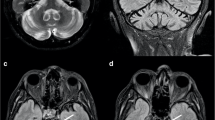Abstract
Spinocerebellar ataxia type 3 or Machado–Joseph disease is the most common spinocerebellar ataxia. In this neurological disease, anatomical, physiological, clinical, and functional neuroimaging demonstrate a degenerative process besides the cerebellum. We performed neurophysiological and neuroimaging studies—polysomnography, transcranial sonography, vestibular-evoked myogenic potential, single-photon emission computed tomography (SPECT) with 99mTc-TRODAT-1, and a formal neuropsychological evaluation in a patient with sleep complaints and positive testing for Machado–Joseph disease, without cerebellar atrophy, ataxia, or cognitive complaints. Polysomnography disclosed paradoxical high amplitude of submental muscle, characterizing REM sleep without atonia phenomenon. Transcranial sonography showed hyperechogenicity of the substantia nigra. There was an absence of vestibular-evoked myogenic potentials on both sides in the patient under study, in opposite to 20 healthy subjects. Brain imaging SPECT with 99mTc-TRODAT-1 demonstrated a significant lower DAT density than the average observed in six healthy controls. Electroneuromyography was normal. Neuropsychological evaluation demonstrated visuospatial and memory deficits. Impairment of midbrain cholinergic and pontine noradrenergic systems, dysfunction of the pre-synaptic nigrostriatal system, changes in echogenicity of the substantia nigra, and damage to vestibulo-cervical pathways are supposed to occur previous to cerebellar involvement in Machado–Joseph disease.




Similar content being viewed by others
References
Schöls L, Bauer P, Schmidt T, Schulte T, Riess O. Autosomal dominant cerebellar ataxias: clinical features, genetics, and pathogenesis. Lancet Neurol. 2004;3:291–304.
Riess O, Rüb U, Pastore A, Bauer P, Schöls L. SCA3: neurological features, pathogenesis and animal models. Cerebellum. 2008;7:125–37.
Pedroso JL, Braga-Neto P, Felício AC, et al. Sleep disorders in Machado-Joseph disease: frequency, discriminative thresholds, predictive values, and correlation with ataxia-related motor and non-motor features. Cerebellum. 2011;10:291–5.
Braga-Neto P, Pedroso JL, Alessi H, et al. Cerebellar cognitive affective syndrome in Machado-Joseph disease: core clinical features. Cerebellum. 2011;11:549–56.
Pedroso JL, França Jr MC, Braga-Neto P, et al. Nonmotor and extracerebellar features in Machado-Joseph disease: a review. Mov Disord. 2013;28:1200–8.
Rub U, Brunt ER, Deller T. New insights into the pathoanatomy of spinocerebellar ataxia type 3 (Machado–Joseph disease). Curr Opin Neurol. 2008;21:111–6.
Braga-Neto P, Felicio AC, Hoexter MQ, et al. Cognitive and olfactory deficits in Machado-Joseph disease: a dopamine transporter study. Parkinsonism Relat Disord. 2012;18:854–8.
Braga-Neto P, Dutra LA, Pedroso JL, et al. Cognitive deficits in Machado-Joseph disease correlate with hypoperfusion of visual system areas. Cerebellum. 2012;11:1037–44.
Malloy-Diniz L, Lasmar V, Gazinelli L, Fuentes D, Salgado J. The Rey auditory-verbal learning test: normas para uma população brasileira. Rev Bras Neurol. 2000;36:76–83.
Oliveira MS, Rigoni MS. Figuras complexas de Rey: teste de cópia e de reprodução de memória de figuras geométricas complexas (1st Ed.). Sao Paulo, Casa do Psicólogo.
Pedroso JL, Braga-Neto P, Felício AC, et al. Sleep disorders in Machado-Joseph disease: a dopamine transporter imaging study. J Neurol Sci. 2013;324:90–3.
Pedroso JL, Braga-Neto P, Felício AC, et al. Sleep disorders in cerebellar ataxias. Arq Neuropsiquiatr. 2011;69:253–7.
D'Abreu A, Friedman J, Coskun J. Non-movement disorder heralds symptoms of Machado-Joseph disease years before ataxia. Mov Disord. 2005;20:739–41.
Braak H, Del Tredici K, Bratzke H, Hamm-Clement J, Sandmann-Keil D, Rüb U. Staging of the intracerebral inclusion body pathology associated with idiopathic Parkinson’s disease (preclinical and clinical stage). J Neurol. 2002;249:1–5.
Pedroso JL, Bor-Seng-Shu E, Felício AC, Braga-Neto P, Teixeira MJ, Barsottini OG. Transcranial sonography findings in spinocerebellar ataxia type 3 (Machado-Joseph disease): a cross-sectional study. Neurosci Lett. 2011;504:98–101.
Friedman A, Galazka-Friedman J. The history of the research of iron in parkinsonian substantia nigra. J Neural Transm. 2012;119:1507–10.
Takegoshi H, Murofushi T. Vestibular evoked myogenic potentials in patients with spinocerebellar degeneration. Acta Otolaryngol. 2000;120:821–4.
Escorcio Bezerra ML, Pedroso JL, Pinheiro DS, et al. Pattern of peripheral nerve involvement in Machado-Joseph disease: neuronopathy or distal axonopathy? A clinical and neurophysiological evaluation. Eur Neurol. 2013;69:129–33.
Graves TD, Guiloff RJ. SCA3 presenting as an isolated axonal polyneuropathy. Arch Neurol. 2011;68:653–5.
Radvany J, Camargo CH, Costa ZM, Fonseca NC, Nascimento ED. Machado-Joseph disease of Azorean ancestry in Brazil: the Catarina kindred. Neurological, neuroimaging, psychiatric and neuropsychological findings in the largest known family, the “Catarina” kindred. Arq Neuropsiquiatr. 1993;51:21–30.
Kawai Y, Takeda A, Abe Y, Washimi Y, Tanaka F, Sobue G. Cognitive impairments in Machado-Joseph disease. Arch Neurol. 2004;61:1757–60.
Roeske S, Filla I, Heim S, et al. Progressive cognitive dysfunction in spinocerebellar ataxia type 3. Mov Disord. 2013;28:1435–8.
Braga-Neto P, Almeida Dutra L, Pedroso JL, Barsottini OG. Cognitive dysfunction in spinocerebellar ataxia type 3: variable topographies and patterns. Mov Disord 2013 Dec 11 [Epub ahead of print].
Conflict of Interests
We have no conflict of interest.
Funding Statement
This research received no specific grant from any funding agency in the public, commercial, or not-for-profit sectors.
Ethical Statement
Full consent was obtained from the patient and healthy subjects referred herein. This study was approved by our Ethics Institution—Universidade Federal de São Paulo.
Author information
Authors and Affiliations
Corresponding author
Rights and permissions
About this article
Cite this article
Pedroso, J.L., Bor-Seng-Shu, E., Braga-Neto, P. et al. Neurophysiological Studies and Non-Motor Symptoms Prior to Ataxia in a Patient with Machado–Joseph Disease: Trying to Understand the Natural History of Brain Degeneration. Cerebellum 13, 447–451 (2014). https://doi.org/10.1007/s12311-014-0553-8
Published:
Issue Date:
DOI: https://doi.org/10.1007/s12311-014-0553-8




